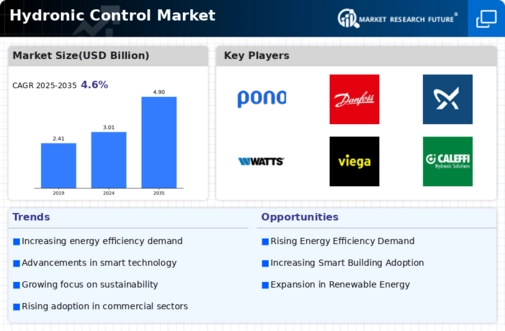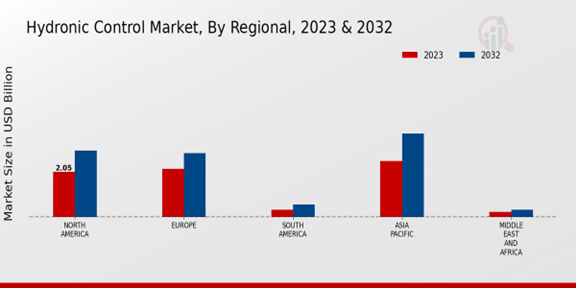Market Growth Projections
Rising Demand for Energy Efficiency
The Global Hydronic Control Market Industry experiences a notable surge in demand for energy-efficient solutions. As energy costs continue to rise, consumers and businesses alike are increasingly seeking systems that optimize energy consumption. Hydronic controls, which regulate heating and cooling systems, play a pivotal role in enhancing energy efficiency. For instance, the integration of smart thermostats and variable speed pumps can lead to substantial energy savings. This trend is expected to drive the market's growth, with projections indicating a market value of 3.01 USD Billion in 2024, reflecting a growing awareness of sustainable practices.
Growing Awareness of Indoor Air Quality
The increasing focus on indoor air quality (IAQ) drives demand within the Global Hydronic Control Market Industry. As health concerns related to air quality gain prominence, consumers are more inclined to invest in systems that enhance IAQ. Hydronic controls contribute to better temperature regulation and humidity control, which are essential for maintaining a healthy indoor environment. For instance, systems that integrate hydronic heating with ventilation can significantly improve air quality. This heightened awareness is expected to propel market growth, as more individuals prioritize health and comfort in their living and working spaces.
Regulatory Support for Sustainable Practices
Government regulations promoting sustainability significantly impact the Global Hydronic Control Market Industry. Many countries are implementing stringent energy efficiency standards and incentives for adopting advanced heating and cooling technologies. These regulations encourage the use of hydronic control systems, which are known for their energy-saving capabilities. For example, initiatives aimed at reducing carbon emissions often include provisions for upgrading existing systems to more efficient hydronic solutions. This regulatory support is likely to bolster market growth, as businesses and homeowners seek compliance with evolving standards while benefiting from reduced energy costs.
Technological Advancements in Hydronic Systems
Technological innovations significantly influence the Global Hydronic Control Market Industry. The advent of smart technologies, such as IoT-enabled devices, allows for real-time monitoring and control of hydronic systems. These advancements facilitate improved performance, reliability, and user experience. For example, smart controls can adjust heating and cooling based on occupancy patterns, enhancing comfort while minimizing energy waste. As these technologies become more prevalent, they are likely to attract investments and drive market growth, with an anticipated CAGR of 4.54% from 2025 to 2035, indicating a robust future for hydronic control solutions.
Increasing Urbanization and Infrastructure Development
Urbanization and infrastructure development are key drivers of the Global Hydronic Control Market Industry. As cities expand and new buildings are constructed, the demand for efficient heating and cooling systems rises. Hydronic controls are essential in modern construction, providing effective climate control solutions that meet the needs of urban populations. For instance, large-scale residential and commercial projects increasingly incorporate hydronic systems to ensure optimal energy use and comfort. This trend is expected to contribute to the market's growth, with projections suggesting a market value of 4.9 USD Billion by 2035, highlighting the importance of hydronic controls in urban environments.












